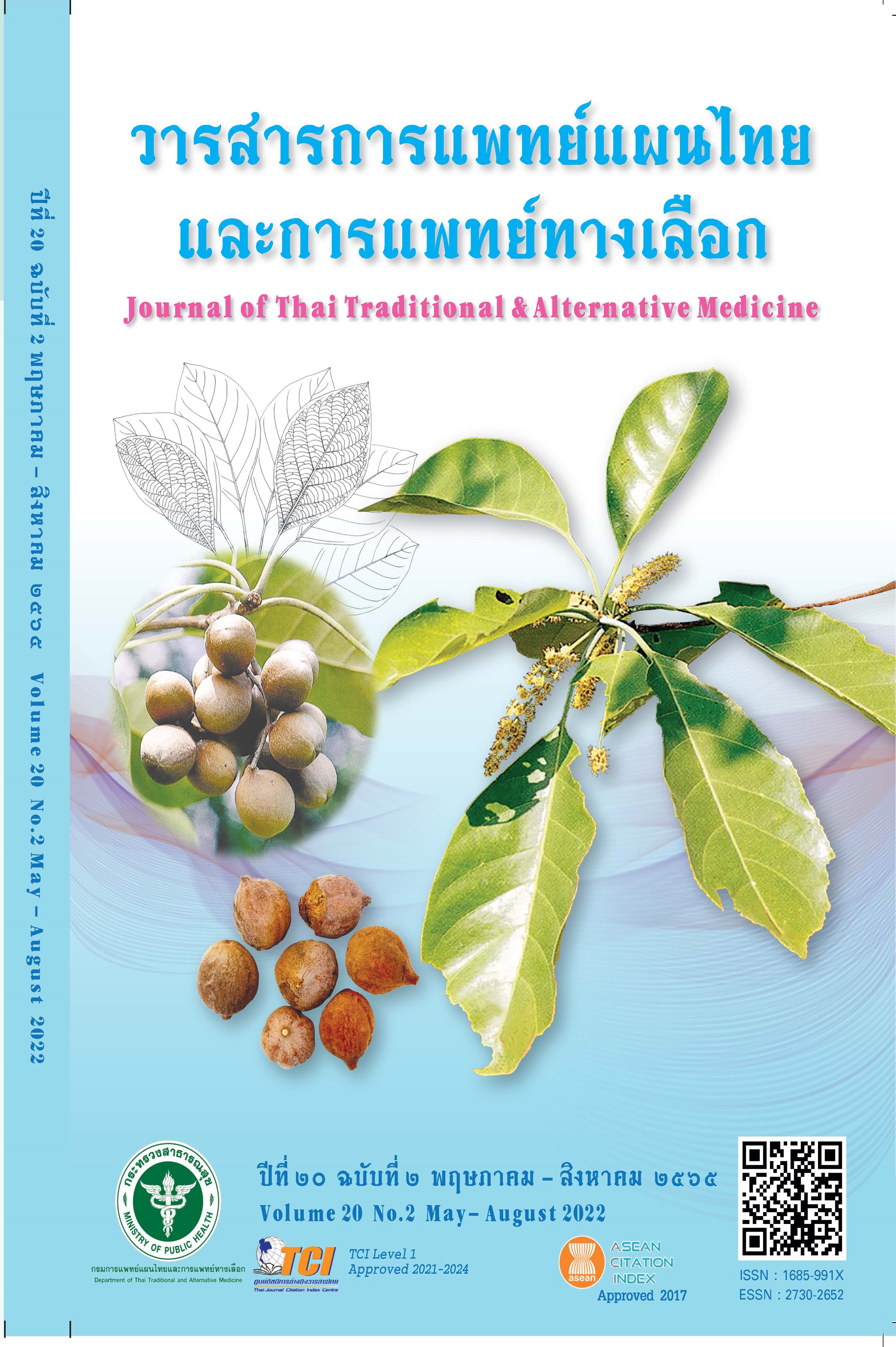รูปแบบการสั่งใช้ ความปลอดภัย และผลต่อคุณภาพชีวิตของตำรับยาศุขไสยาศน์
Main Article Content
บทคัดย่อ
ตำรับยาศุขไสยาศน์เป็นตำรับยาแผนไทยที่มีกัญชาปรุงผสมในคัมภีร์ธาตุพระนารายณ์ โดยคำแนะนำของกรมการแพทย์แผนไทยและการแพทย์ทางเลือกและสภาการแพทย์แผนไทย มีใบกัญชาเป็นส่วนประกอบในตำรับร้อยละ 15.38 และมีสรรพคุณช่วยให้นอนหลับและเจริญอาหาร แม้ว่าในอดีตมีการนำกัญชามาใช้เป็นยารักษาโรคมาอย่างยาวนาน แต่ด้วยพระราชบัญญัติยาเสพติดให้โทษ พ.ศ. 2522 ได้กำหนดให้กัญชาเป็นยาเสพติดให้โทษประเภทที่ 5 การใช้ตำรับยาไทยที่มีกัญชาในอดีตจึงเป็นสิ่งผิดกฎหมาย ทำให้งานวิจัยและหลักฐานเชิงประจักษ์เกี่ยวกับการใช้ ประสิทธิภาพและความปลอดภัยของยามีจำนวนน้อย การศึกษานี้จึงมีวัตถุประสงค์เพื่อศึกษารูปแบบการสั่งใช้ยา อาการไม่พึงประสงค์ และคุณภาพชีวิตของผู้ป่วยที่ได้รับตำรับยาศุขไสยาศน์ โดยทำการศึกษาแบบเก็บข้อมูลย้อนหลังแบบ retrospective cohort study จากเวชระเบียนของผู้มารับการรักษาที่คลินิกกัญชาทางการแพทย์ โรงพยาบาลการแพทย์แผนไทยและการแพทย์ผสมผสานในระหว่างวันที่ 1 ตุลาคม 2562–31 ธันวาคม 2563 ที่มาติดตามผลการรักษาทุก 1 เดือนและมารับบริการอย่างน้อย 2 ครั้ง ผลการศึกษาพบว่า จำนวนผู้ป่วยที่แพทย์สั่งใช้ตำรับยาศุขไสยาศน์ จำนวน 138 คน เป็นเพศชายร้อยละ 61.59 มีอายุเฉลี่ย 56.81 ± 15.51 ปี มีข้อบ่งใช้ส่วนใหญ่ คือ อาการนอนไม่หลับ ร้อยละ 87.68 รองลงมาคือ อาการปวดศีรษะ ร้อยละ 7.97 และอาการอื่น ๆ ได้แก่ อาการเบื่ออาหาร อาการชา และโรคพาร์กินสัน ร้อยละ 4.35 ขนาดเริ่มต้นที่มีการสั่งใช้อยู่ในช่วง 0.5-2.0 กรัมต่อวัน รูปแบบการสั่งใช้เริ่มต้นส่วนใหญ่คือ 1 กรัม วันละ 1 ครั้ง (ร้อยละ 52.90) ส่วนขนาดพยุง (maintenance dose) ส่วนใหญ่ที่ผู้ป่วยได้รับ คือ 2 กรัมต่อวัน (ร้อยละ 44.18) รองลงมาคือ 1 กรัมต่อวัน (ร้อยละ 40.70) มีการยุติการรักษาเนื่องจากอาการไม่ดีขึ้น จำนวน 15 คน (ร้อยละ 10.87) การเกิดเหตุการณ์ไม่พึงประสงค์พบ 31 เหตุการณ์ในผู้ป่วย 23 ราย เหตุการณ์ไม่พึงประสงค์ที่พบบ่อยที่สุด ได้แก่ ระคายเคืองทางเดินอาหาร ร้อยละ 7.97, วิงเวียนหรือปวดศีรษะ ร้อยละ 5.79, ปากแห้งคอแห้ง ร้อยละ 4.34 เป็นต้น มีผู้ป่วยยุติการรักษาเนื่องจากเกิดเหตุการณ์ไม่พึงประสงค์จำนวน 16 คน (ร้อยละ 11.59) ส่วนข้อมูลด้านคุณภาพชีวิตเก็บข้อมูลจากแบบสอบถาม EQ-5D-5L พบว่า ค่าอรรถประโยชน์เฉลี่ยเพิ่มขึ้นอย่างมีนัยสำคัญทางสถิติ (P < .001) โดยค่าเฉลี่ยคะแนนอรรถประโยชน์ก่อนเริ่มการรักษา คือ 0.95 ± 0.11 และหลังได้รับการรักษาในเดือนที่ 3 คือ 0.98 ± 0.05 จึงสรุปได้ว่า การใช้ตำรับยาศุขไสยาศน์ช่วยเพิ่มคุณภาพชีวิตของผู้ป่วยและมีความปลอดภัย แม้จะพบอาการไม่พึงประสงค์แต่เป็นเหตุการณ์ที่ไม่รุนแรง จึงสามารถพิจารณาเป็นการรักษาที่เป็นทางเลือกให้กับผู้ป่วยสำหรับบรรเทาอาการนอนไม่หลับได้
Article Details

This work is licensed under a Creative Commons Attribution-NonCommercial-NoDerivatives 4.0 International License.
References
Taupachit W, Kessomboon N. Medicinal use of cannabis. Isan J Pharm Sciences. 2017;13(Supplement):228-40. (in Thai)
Narcotics Act B.E. 2522 (1979). Published in Government Gazette, Vol. 96, Part 63. (1979 Apr 27). (in Thai)
Narcotics Act (No. 7) B.E. 2562 (2019). Published in Government Gazette, Vol. 136, Part 19A. (2019 Feb 18). (in Thai)
Notification of the Ministry of Public Health on Prescribing schedule 5 narcotic medicines, containing cannabis as an ingredient, that can be consumed for the treatment of diseases or for research B.E. 2562 (2019). Published in Government Gazette, Vol. 136 Special Part 94D. (2019 Apr 11). (in Thai)
Notification of the Committee on the Development of National Medicine System on National list of essential herbal medicines B.E. 2564 (2021). Published in Government Gazette, Vol. 138 Special Part 103D. (2021 May 14).
Notification of the Ministry of Public Health on Specifying
schedule 5 narcotics B.E. 2563 (2020). Published in Government Gazette. Vol. 137. Special Part 290 D. (2020 Dec 14). (in Thai)
Notification of the Ministry of Public Health on Prescribing schedule 5 narcotic medicines, containing cannabis as an ingredient, that can be consumed for the treatment of diseases or for research B.E. 2564 (2021). Published in Government Gazette, Vol. 138 Special Part 35 D. (2021 Feb 15). (in Thai)
Protection of Thai Traditional Medicine Knowledge Office, Department of Thai Traditional and Alternative Medicine. Kampee That Phra Narai, palm leaf edition. Bangkok: War Veterans Administration Printing; 2012.
p. 89. (in Thai)
Department of Medical Services. Guidance on cannabis for medical use, Version 4. Nonthaburi: Department of Medical Services; 2021. (in Thai)
Lueangchiranothai P, Palawong S, Kamol T. Effectiveness
of cannabis extract at medical cannabis clinic in Lampang Hospital. J Thai Trad Alt Med. 2021;19(1):19-33. (in Thai)
Bhagavan C, Kung S, Doppen M, John M, Vakalalabure I, Oldfield K, Braithwaite I, Newton-Howes G. Cannabinoids in the treatment of insomnia disorder: A systematic review and meta-analysis. CNS Drugs.
;34(12):1217-28.
Tengtermwong N. Effectiveness and safety of Suk Saiyad herbal remedy for chronic insomnia: A preliminary retrospective study in Chao Phya Abhaibhubejhr Hospital. J Thai Trad Alt Med. 2021;19(2):331-43. (in Thai)
Tipratchadaporn S, Srita J, Pomchaiya P, Boonyawan S, Silarak K. Benefit and safety of Suk Sai-yad traditional medicine recipe in patients with insomnia. J Thai Trad Alt Med. 2021;19(2):317-30. (in Thai)
Pattanaphesaj J. Health-related quality of life measure (EQ-5D-5L): measurement property testing and its preference-based score in Thai population (Doctoral dissertation). Nakhon Pathom: Mahidol University; 2014.
Department of Thai Traditional and Alternative Medicine. Guidance on the use cannabis in Thai traditional medicine. Nonthaburi: Ministry of Public Health; 2019. (in Thai)
Myers BM, Smith JL, Graham DY. Effect of red pepper and black pepper on the stomach. Am J Gastroenterol. 1987;82(3):211-4.
Pratt M, Stevens A, Thuku M, Butler C, Skidmore B, Wieland LS, et al. Benefits and harms of medical cannabis: a scoping review of systematic reviews. Syst Rev. 2019;8(1):320.
Deshpande A, Mailis-Gagnon A, Zoheiry N, Lakha SF. Efficacy and adverse effects of medical marijuana for chronic noncancer pain: Systematic review of randomized controlled trials. Can Fam Physician. 2015;61(8):e372-e81.

